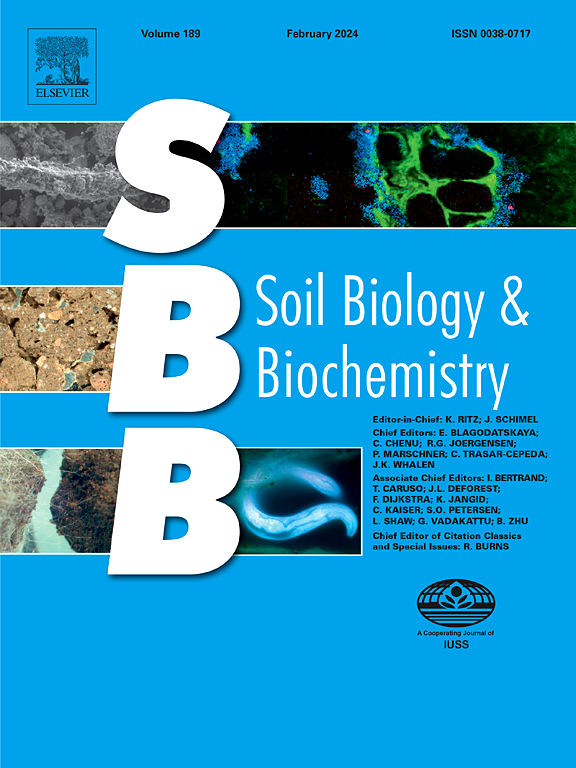植物群落组成和性状调节干旱强度对土壤微生物群落组成和功能的影响
IF 9.8
1区 农林科学
Q1 SOIL SCIENCE
引用次数: 0
摘要
陆地生态系统正日益受到极端干旱事件的威胁。土壤微生物群落在调节生物地球化学循环方面发挥着重要作用,是陆地生态系统功能的核心。因此,日益严重的干旱事件对土壤微生物群落的影响将对生态系统如何应对气候变化产生连锁反应。在室外草地中观实验中,我们确定了干旱强度的增加如何影响干旱期间和干旱后细菌和真菌群落的组成和功能。我们还测试了植物群落资源获取策略(快速策略植物群落与慢速策略植物群落)、植物群落组成和植物功能特征是否介导了土壤微生物对干旱强度增加的反应。我们发现,干旱强度的增加明显改变了细菌和真菌群落的组成,这些影响一直持续到实验结束(复湿后两个月)。经历过严重干旱的细菌和真菌群落没有恢复到基线组成,而经历过轻度干旱的群落则恢复到了基线组成。在干旱高峰期和复湿后不久,微生物群落的功能(潜在的胞外酶活性)都有所降低。虽然干旱强度对细菌或真菌群落的影响对植物群落资源获取策略不敏感,但功能群丰度(禾本科或草本植物物种的地上生物量)组成(禾本科与草本植物的比例)和叶片特征(叶片干物质含量和叶片氮浓度)解释了干旱期间和干旱后细菌和真菌群落组成的显著变化。值得注意的是,植物群落叶片干物质含量和土壤氮是介导干旱强度增加对微生物指示类群(ASVs)影响的关键因素。我们的结论是,干旱强度的增加会在干旱期间和之后影响草地土壤微生物群落,而这种影响受到植物群落组成和功能特征的影响。本文章由计算机程序翻译,如有差异,请以英文原文为准。
Plant community composition and traits modulate the impacts of drought intensity on soil microbial community composition and function
Terrestrial ecosystems are increasingly threatened by extreme drought events. Soil microbial communities are central to terrestrial ecosystem function via their role in regulating biogeochemical cycling. Consequently, the impact of increasingly intense drought events on soil microbial communities will have knock-on effects for how ecosystems cope with climate change. In an outdoor grassland mesocosm experiment, we determined how increasing drought intensity affects bacterial and fungal community composition, and functioning, during and after drought. We also tested whether plant community resource acquisition strategy (fast-versus slow-strategy plant communities), plant community composition, and plant functional traits mediate soil microbial responses to increasing drought intensity. We found that increasing drought intensity markedly shifted bacterial and fungal community composition, and these effects persisted until the end of the experiment (two months after re-wetting). Bacterial and fungal communities that experienced severe droughts did not return to baseline composition, while those that experienced a mild drought did. Microbial community functioning (potential extracellular enzyme activity) was reduced at peak drought and shortly after re-wetting. While drought intensity effects on bacterial or fungal communities were insensitive to plant community resource acquisition strategy, functional group abundance (aboveground biomass of grass or forb plant species) composition (grass:forb ratio) and leaf traits (leaf dry matter content and leaf nitrogen concentration) explained significant variation in bacterial and fungal community composition during and after drought. Notably, plant community leaf dry matter content and soil nitrogen were the key factors mediating the effect of increasing drought intensity on microbial indicator taxa (ASVs). We conclude that increasing drought intensity affects grassland soil microbial communities during and after drought, and this impact is influenced by plant community composition and functional traits.
求助全文
通过发布文献求助,成功后即可免费获取论文全文。
去求助
来源期刊

Soil Biology & Biochemistry
农林科学-土壤科学
CiteScore
16.90
自引率
9.30%
发文量
312
审稿时长
49 days
期刊介绍:
Soil Biology & Biochemistry publishes original research articles of international significance focusing on biological processes in soil and their applications to soil and environmental quality. Major topics include the ecology and biochemical processes of soil organisms, their effects on the environment, and interactions with plants. The journal also welcomes state-of-the-art reviews and discussions on contemporary research in soil biology and biochemistry.
 求助内容:
求助内容: 应助结果提醒方式:
应助结果提醒方式:


